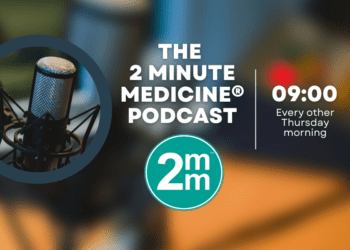Mediterranean diet adherence and risk of diabetes kidney disease
1. In a cohort of patients with hyperglycemia, adherence to a Mediterranean diet (MED) was associated with decreased microvascular complications such as diabetic kidney disease (DKD).
2. The results did not change based on other variables such as hypertension and physical activity, however, age ≤ 55 was associated with a lower risk of DKD.
Evidence Rating Level: 1 (Excellent)
Study Rundown: Type 2 diabetes mellitus (T2DM) is a chronic disease associated with many complications including micro- and macrovascular complications. Some microvascular complications are diabetes kidney disease (DKD), diabetic neuropathy (DN), and diabetic retinopathy (DR), which have a high prevalence and lead to significant mortality worldwide. Patients with non-diabetes hyperglycemia experience microvascular complications as well and it is important to understand protective factors. A prospective cohort study was conducted to better understand the association between a Mediterranean diet (MED) and microvascular complications in patients with hyperglycemia. The Alternate Mediterranean Diet (AMED) score, a slightly modified version of the traditional MED score, determines how much of an individual’s diet can be considered MED. This score was calculated for each participant, with scores ranging from 0 to 9 based on dietary patterns, with more points assigned for higher consumption of typical MED foods (such as whole grains, fish, and legumes). The positive effects of the MED diet on renal function can likely be due to the foods in the diet which provide a high source of vitamins C and E, β carotene, and polyphenols, which may reduce oxidative damage. In summary, better adherence to the MED was associated with a decreased risk of DKD in hyperglycemic patients.
Click here to read the study in BMC Medicine
Relevant reading: Mediterranean diet effects on type 2 diabetes prevention, disease progression, and related mechanisms. A review
In-Depth [Prospective Cohort Study]: To understand the effectiveness of MED on individuals with T2DM, the association between microvascular complications in hyperglycemic patients was investigated. Participants with hyperglycemia and T2DM were included in the study, while those with a previous diagnosis of microvascular complications or with incomplete dietary patterns were excluded. During the median follow-up time of 12.3 years, the study saw 3392 cases of microvascular complications consisting of 1084 cases of diabetic retinopathy (DR), 632 cases of diabetic neuropathies (DN), and 2184 of diabetic kidney disease (DKD). Once the results had been adjusted for confounding variables, they showed that a higher AMED score was associated with greater protection against DKD in patients with hyperglycemia. Specifically, when comparing the highest and lowest scores, a hazard ratio of 0.79 [95% CIs: 0.67, 0.94] for DKD resulted in patients with hyperglycemia proving that higher adherence to AMED results in protective effects. When specifically looking at the role of legumes, each incremental increase in consumption led to a potential 8% reduction in DKD risk in hyperglycemic patients (HR, 0.92; 95% CI: 0.84, 1.01), and in hyperglycemic patients with T2DM (HR, 0.89; 95% CI: 0.77, 0.99). Further results showed that AMED has greater protective effects against DKD in patients with hyperglycemia and T2DM (HR, 0.64; 95% CI: 0.5, 0.83) compared to patients without T2DM. The values for DKD, DR, or DN were affected by age, with the risk being lower in patients ≤ 55 years (P = 0.001), but it was not affected by gender, physical activity, or hypertension. Similar to previous studies, this one showed an association between adherence to MED and decreased risk of DKD.
Image: PD
©2024 2 Minute Medicine, Inc. All rights reserved. No works may be reproduced without expressed written consent from 2 Minute Medicine, Inc. Inquire about licensing here. No article should be construed as medical advice and is not intended as such by the authors or by 2 Minute Medicine, Inc.







